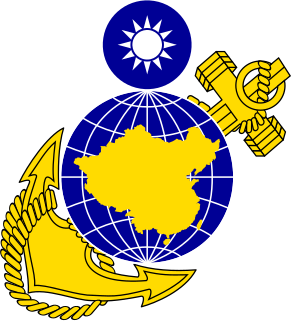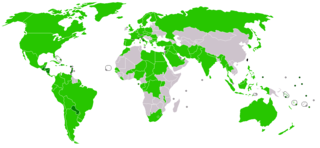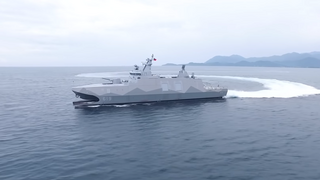
The Republic of China Armed Forces are the armed forces of the Republic of China (ROC) now on Taiwan, encompassing the Army, Navy, Air Force and Military Police Force. The military is under the civilian control of the Ministry of National Defense and oversight by the Legislative Yuan. It was the National Revolutionary Army before being renamed as the Republic of China Armed Forces in 1947 due to the implementation of the newly promulgated Constitution of the Republic of China. It was also historically referred as the Chinese National Armed Forces and uncommonly known as the Taiwanese Armed Forces.

The flag of the Republic of China, also known as the Blue Sky, White Sun, and a Wholly Red Earth (青天白日滿地紅) retroactively, the National Flag of China, and commonly referred to as the Flag of Taiwan, consists of a red field with a blue canton bearing a white disk surrounded by twelve triangles; said symbols symbolize the sun and rays of light emanating from it, respectively.

Pratas Island is an island in the northern part of the South China Sea administered as part of Cijin District, Kaohsiung, Republic of China (Taiwan) nominally part of its dormant Hainan Special Administrative Region. It is located about 170 nautical miles southeast of Hong Kong. It has an area of about 240 hectares, including 64 hectares of lagoon, and is the largest of the South China Sea Islands. It is the location of the Dongsha Airport.

Yukikaze was a Kagerō-class destroyer in service with the Imperial Japanese Navy during World War II. She was the only member of her class to survive the war, and did so without suffering any major damage. Following the war, the ship was transferred to the Republic of China Navy, where she was renamed Tan Yang (DD-12) (丹陽) and served until 1966, before being scrapped in 1970.

The First Taiwan Strait Crisis was a brief armed conflict between the Communist People's Republic of China (PRC) and the Nationalist Republic of China (ROC) in Taiwan. The conflict focused on several groups of islands in the Taiwan Strait that were held by the ROC but were located only a few miles from mainland China. The crisis began when the PRC shelled the ROC-held island of Kinmen (Quemoy). Later, the PRC seized the Yijiangshan Islands from the ROC. Under pressure by the PRC, the ROC then abandoned the Tachen Islands, which were evacuated by the navies of the ROC and the US.

The Republic of China Navy (ROCN), also called the ROC Navy or Taiwan Navy, is the maritime branch of the Republic of China Armed Forces on Taiwan. Due to the political status of Taiwan, the service was formerly commonly called the Chinese Navy.

The Republic of China Marine Corps, also known colloquially as the Taiwan Marine Corps, is the amphibious arm of the Republic of China Navy (ROCN) responsible for amphibious combat, counter-landing and reinforcement of the areas under the jurisdiction of the Republic of China (ROC), including the island of Taiwan, Kinmen, and the Matsu Islands, and defense of ROCN facilities, also functioning as a rapid reaction force and a strategic reserve capable of amphibious assaults.

The Republic of China Military Police is a military police body under the Ministry of National Defense of the Republic of China on Taiwan. Unlike military police in many other countries, the ROCMP is a separate branch of the ROC Armed Forces. ROCMP is responsible for protecting government leaders from assassination or capture, guarding Taiwan's strategic facilities, and counterintelligence against enemy infiltrators, spies, and saboteurs.
Republic of China on Taiwan is a political term as well as discourse regarding the present status of the Republic of China. It is proposed by former President of the Republic of China Lee Teng-hui, the first locally-born president. During his presidential tenure in 1995, Lee visited his alma mater Cornell University and mentioned this term for the first time when delivering an Olin Lecture.

Numerous states have ceased their diplomatic recognition of the Republic of China during the last 70 years - since the founding of the People's Republic of China.

Bilateral relations between the Russian Federation's predecessor the Union of Soviet Socialist Republics and the Republic of China were established from 1922 until 1949 when it switched to the recognition of the People's Republic of China.
In Taiwan, the White Terror was the suppression of political dissidents following the February 28 incident by the Government of the Republic of China ruled by the Kuomintang.

The Tuo Chiang-class corvette is a Taiwanese-designed class of fast and stealthy multi-mission corvettes built for the Republic of China (Taiwan) Navy. It is designed to counter the numerous and increasingly sophisticated People's Liberation Army Navy ships by utilizing hit-and-run tactics, and thus featured clean upper structure design with very few extrusions to reduce radar signature, pre-cooled engine exhaust to reduce infrared signature, and a reduced visual signature to reduce chance of detection.

The 1987 Lieyu massacre, also known as the March 7 Incident, Donggang Incident or Donggang Massacre, occurred on 7 March 1987 at Donggang Bay, Lieyu Island, Kinmen, Fujian, Republic of China. According to the diary of Superior-general Hau Pei-tsun, nineteen unarmed Vietnamese boat people were killed by the ROC military. There may have been more than nineteen deaths, containing several families of ethnical Chinese speaking minority.
Kim Chong-kon is a former South Korean admiral, diplomat and politician, serving as the Chief of Naval Operations, the Ambassadors to the Republic of China (ROC) in Taiwan, and a member of National Assembly before retirement. Started his military career in 1951, Kim participated several maritime operations during the Korean War and the Cold War, assigned to positions like warship commander, flotilla commander, naval station commander, fleet commander and senior staff in the Navy Headquarters. Kim also gained himself several medals from South Korea and Taiwan for his efforts on military and foreign affairs.

E.A. — Extraordinary Accident is a 1958 Soviet drama film directed by Viktor Ivchenko. It was the box office leader of 1959 in the Soviet Union having had more than 47 million viewers. The film is based on real events of the capture of the Soviet tanker "Tuapse" in 23 June 1954.
The guanbi policy or closed port policy (闭港政策) was a military blockade policy of the government of the Republic of China (ROC) against the People's Republic of China (PRC). On 18 June 1949, ROC Government announced the aerial and naval blockade policy along the Chinese coast from Liao River to Min River area starting on 26 June. The application area was extended further southwest to include the Guangdong Province in February 1950.

USS LST-755 was a LST-542-class tank landing ship in the United States Navy during World War II. She was transferred to the Republic of China Navy as ROCS Chung Hai (LST-201).
PLANS Mount Tai was the first submarine tender of the People's Liberation Army Navy (PLAN),and during most of its service life, it was the largest ship in PLAN.













